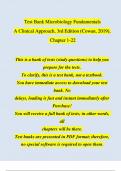Exam (elaborations)
Test Bank Microbiology Fundamentals A Clinical Approach, 3rd Edition By Cowan, Chapter 1-22 |Complete All Chapters Latest, 100 % Verified
- Course
- Institution
- Book
Test Bank Microbiology Fundamentals A Clinical Approach, 3rd Edition By Cowan, Chapter 1-22 |Complete All Chapters Latest, 100 % Verified Test Bank Microbiology Fundamentals A Clinical Approach, 3rd Edition By Cowan, Chapter 1-22 |Complete All Chapters Latest, 100 % Verified
[Show more]



